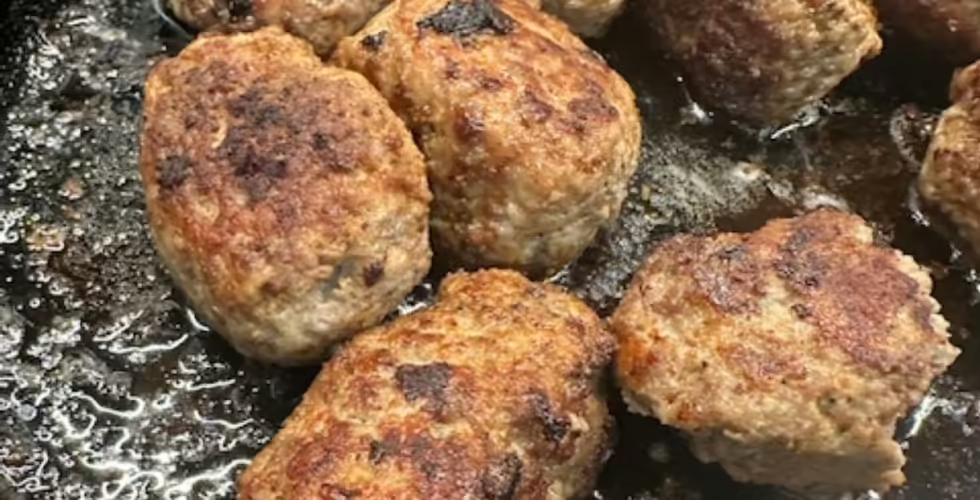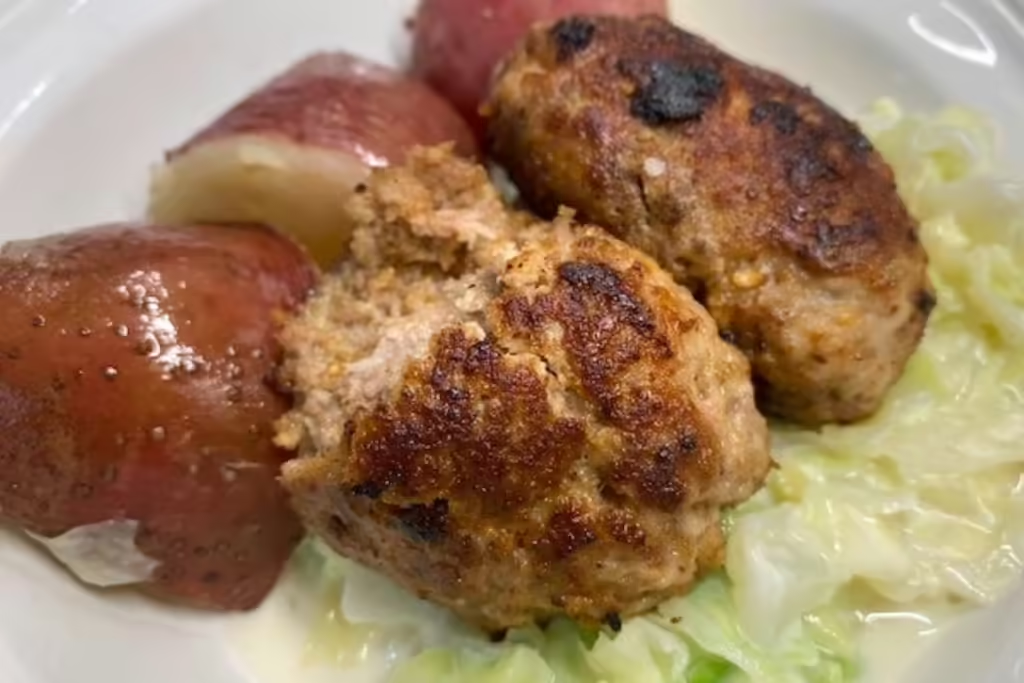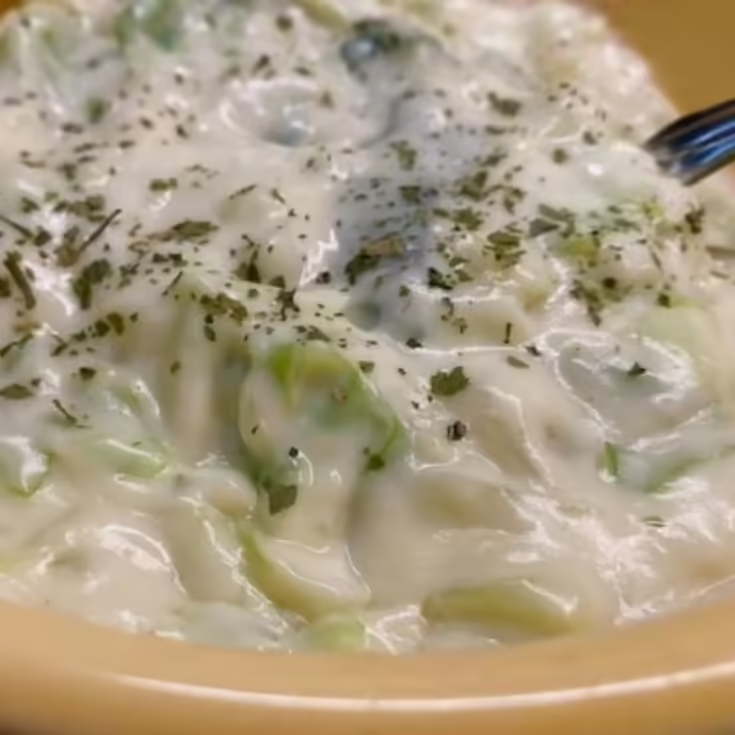
"Frikadeller," which translates to Danish meatballs, is a staple often served in Danish kitchens. In fact, they're considered a Danish national dish!
Frikadeller is an odd name for a super tasty oval meatball. I grew up on them, and two of my classmates fondly remember their mothers making them often. Only about five percent of Americans report having Danish ancestry, and while few, we are all fiercely proud of our heritage.

Frikadeller is typically served with boiled potatoes and creamed or sweet and sour cabbage. Frikadeller was a favorite meal at our house when I was growing up. My dad was born in Aalborg, Denmark, and later immigrated to Iowa, surrounded by many other Danes.
Mom always made extra so the leftovers could be sliced the next day and put on open-face sandwiches made on rye bread with pickles and a schmear of some kind. The Danes always eat their sandwiches open-faced with a knife and fork. These Danish-style salt and vinegar cucumbers would be amazing on a frikadeller sandwich!
A shot or two of bone-dry Aquavit often accompanies the sandwiches as part of a social tradition at the typical Scandinavian table. When the host raises his glass, guests make eye contact with each other and take a sip.
Glasses are returned to the table and not lifted again until the host motions to do so—a custom that epitomizes Scandinavian etiquette.

Typically, frikadeller begins with a mixture of ground beef and ground pork for the best flavor and juiciness. I’m sure my mom sometimes made them using only ground beef, but ground pork adds rich flavor, juiciness, and tenderness.
Ground beef is about $6.00 a pound today, but ground pork is under $3.00 at our local grocer, so it's also a great way to stretch the budget while adding authentic flavor!
There are as many versions of frikadeller as there are cooks. Some use oatmeal, and others use flour as a binder, but I used simple dry homemade bread crumbs. My Danish whisk is the perfect tool for combining meats and bread crumbs! Every kitchen needs one of these amazing gadgets!

Next, I added onion, eggs, a bit of milk, salt, and pepper and mixed them all thoroughly. It seemed a bit dry, so I added a couple of tablespoons of cream I had on hand. (Many old recipes call for added milk.)

The mixture should be soft enough to handle easily. It will be a bit sticky, but that helps to achieve the desirable crispy crust.
My Danish friend Mary told me her dad always wanted the outside of his frikadeller to be very dark brown and crisp. My dad did, too, but it’s a preference that developed over time! I stopped at what I thought was a nice brown crust!
Classic frikadellers are oval-shaped and not very big. They are pan-fried in butter on medium-high heat and should be well-browned on all sides. Since frikadellers are fairly small, only about 3 ounces each, they don’t take long to cook.
Once they are brown on all sides, they should be done. Check for sure, but don’t overcook them. You want the inside to be nice and juicy. The internal temperature should be 160 degrees, which can be easily checked with an instant-read thermometer.
If I had been in true Danish form, I would have flattened the frikadeller a little more as they cooked. That also helps cook the yummy meatballs slightly faster!
I turned them over several times as they fried in the skillet to ensure every outside surface was nicely browned. The smell was wonderful and familiar, bringing back lots of fond memories.
The meatballs weren’t quite browned enough in this picture, but they were getting close! Just a few more turns to get all sides!

Few things taste as wonderful with frikadeller as boiled new potatoes, and few things are easier to prepare! These days, small “baby” potatoes are available at the grocery store all year round.
They have thin, delicate skin, a creamy texture, and a wonderful flavor. There is no need to peel them; in fact, their color enhances the look of your plate!
There is no “recipe” for boiled potatoes. A pound of baby potatoes will make about three servings. Place the baby potatoes in a saucepan with a lid, add just enough water to cover them, and add some salt.
Cover and cook the potatoes on medium-high heat for about 20 minutes or until the tip of a knife or cake tester can easily pierce them. Drain and drizzle them with butter to bring out their color and shine.

Creamed cabbage may have gotten a bad rap at some point in your life, and what you remember was probably cooked to a mush and coated with a bland white sauce. Forget that!

The trick to excellent creamed cabbage is to cut it into coarse shreds and cook it with a small amount of water until it is crisp-tender. Add a little salt to the cooking water. There should be a bit of crunch in the cooked cabbage!
Now, drain the cabbage and put it into the serving bowl. Cover it to keep it warm while you make the cream sauce in the same pan. Melt butter (real butter, please) in the pan and whisk in the flour.
Cook the butter and flour, continually whisking until the mixture is bubbly and you have blended in every bit of flour. Don’t hurry this process, and this step is the key to an excellent roux.
Now add the milk (whole milk, please, or even use some cream), continually whisking until the mixture is as thick as you prefer, but if the sauce gets too thick, thin with a bit of milk or cream. Fold the cooked cabbage into the cream sauce and keep the mixture warm until you serve it.
Some cooks add a bit of chicken bouillon to the cream sauce, and others add a dash of nutmeg. I prefer salt and pepper only myself.

Coarsely shredded cabbage is cooked to crisp-tender then cloaked in a creamy white sauce.
Danes love their cabbage! Sweet and sour red cabbage is another popular side dish with frikadeller, and the Danish term for it is Sursøt Rødkål. Red cabbage is loved all over Scandinavia and northern Europe. If you choose this option, use baby Yukon Gold potatoes for the prettiest plate. It is a great combination, too!

Classic oval meatballs are considered a national dish in Denmark. Serve hot or refrigerate and slice for open-faced sandwiches.
This is a basic recipe for a frikadeller. It’s a good place to begin because every Danish kitchen has its particular version.
Some folks like more onion, some prefer less onion, and every Dane likes his cherished meatballs browned a certain way. We hope you make them soon and often until you find how you love them best.
Do you have a little bit of Danish in your heritage? Are there Dansk dishes you grew up with that you still love? If you make a panful of frikadeller, we’d love it if you’d snap a picture and send it to us!
If you liked this frikadeller meatball recipe, you are my people! If you enjoyed this recipe today, please share this post on your social media accounts like Facebook, Instagram, Twitter, and Pinterest.
If you haven't already, please check out my Facebook page and find me on Pinterest, where I will post easy, delicious, and family-friendly recipes every week!
If you enjoyed a post, I'd love it if you would leave a ⭐⭐⭐⭐⭐ review or a comment. It really helps my little business. ❤❤
Love, GB (Betty Streff)
Sign up for my newsletter and receive a free gift! A printable sign that would look great in your kitchen, framed above your sink, or just placed anywhere to remind us how lucky we are to have dirty dishes!
 Sign up now!
Sign up now!